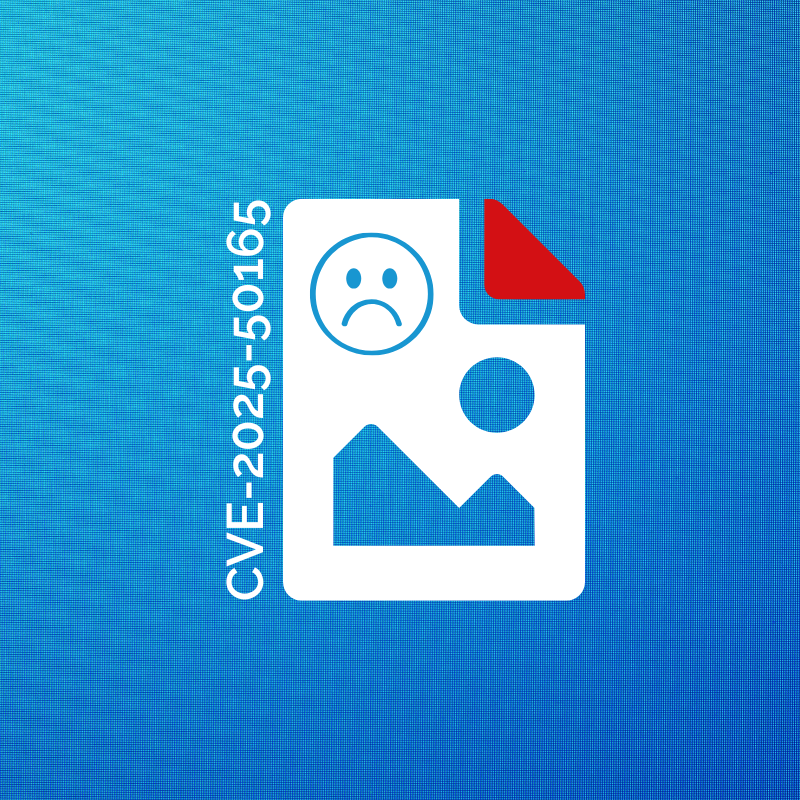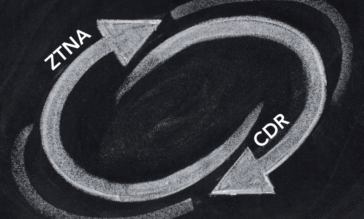CVE-2025-50165: This Windows JPEG Vulnerability Proves Detection Isn’t Enough

A newly disclosed vulnerability, CVE-2025-50165, has opened the door to a different class of threat, one that doesn’t require clicks, macros, or any deliberate action from a user. The flaw sits deep inside the Windows Graphics Component, where the operating system processes something as ordinary as a JPEG. By manipulating the structure of an image, attackers can trigger remote code execution the moment Windows attempts to render it. No prompt. No warning. A preview window quietly becomes the first step in a system compromise.
It’s the latest reminder that attackers don’t always rely on obvious malware or suspicious scripts. Increasingly, they’re converting everyday file formats into delivery mechanisms for hidden exploits. Files that users trust the most, including images, documents, PDFs, and even archives, are becoming the preferred hiding places for sophisticated payloads. This shift marks a troubling trend: the threat isn’t always what a file looks like but what the internal structure can be manipulated to do.
Breaking Down the CVE-2025-50165 Vulnerability
At the center of this vulnerability is a flaw in how Windows handles JPEG decoding. The issue stems from a memory-corruption bug buried inside the Windows Graphics Component, the subsystem responsible for rendering virtually every image that passes through the operating system. When a specially crafted JPEG is processed, the decoder mishandles internal data structures, creating conditions that allow for remote code execution. Nothing about the file needs to look suspicious; the danger lives entirely in the malformed way the image is constructed.
What makes this especially concerning is the complete lack of traditional red flags. There are no macros to disable, no scripts to block, and no links to avoid. The exploit doesn’t wait for someone to double-click or open a suspicious attachment. It activates the moment Windows attempts to preview the image, which can occur automatically in File Explorer, Outlook, Teams, SharePoint, webmail, or any other third-party application.
And because images are everywhere, embedded in documents, pasted into chat messages, attached to support tickets, uploaded to portals, and dropped into shared drives, the reach of this vulnerability is enormous. A single malicious JPEG can travel through an organization unnoticed, silently triggering the exact moment it’s rendered. This is the kind of threat that turns a harmless-looking file into a perfect vehicle for delivery.
The Bigger Picture: File Formats Are the Soft Underbelly of Enterprise Security
This vulnerability highlights a broader problem: file formats have become one of the weakest points in enterprise security. Image-rendering libraries sit deep inside operating systems and applications, often built on old code that’s difficult and risky to update. They’re everywhere inside browsers, productivity tools, and collaboration apps. When a flaw appears in one of these core components, it affects the entire environment.
The same is true for file parsers more broadly. They’re complex pieces of code expected to handle countless variations of “valid” files from different tools and eras. That complexity creates small gaps that attackers can exploit by manipulating the file’s structure rather than embedding obvious payloads. Malformed content slips past parsers precisely because they were never built to defend against weaponized structure.
Enterprises feel this pressure every day. They ingest thousands of files from email, uploads, vendor portals, and collaboration tools, and any one of them can hide a subtle structural flaw that detonates the moment it’s rendered. These attacks generate minimal noise, blend into normal workflows, and grant adversaries a broad reach.
The result is clear: trusted file formats can no longer be trusted at face value.
Why Detection-Based Tools Fail Against This Class of Threat
These flaws in file-handling code reveal where detection-based tools fall short. When an exploit is buried inside the structure of a newly crafted JPEG, there’s no signature for anti-malware tools to match. Behavioral tools don’t catch it either, because nothing about the attack looks suspicious from their perspective. It isn’t a macro calling out to the internet or a rogue process chain. It’s a memory corruption event that occurs during a normal rendering operation.
Sandboxes struggle as well. Image-based exploits often depend on subtle timing or environment-specific conditions that sandboxes can’t replicate. A malicious JPEG might look harmless in analysis, but trigger instantly when a real user previews it on an endpoint with slightly different components.
And users can’t be trained out of opening images. JPEGs are an integral part of everyday communication, from HR messages to vendor submissions, so avoiding them is neither realistic nor sustainable.
This is why threats like CVE-2025-50165 bypass the tools organizations rely on. They don’t generate the signals that detection tools look for, and they exploit one of the most trusted operations on every system: rendering a simple image.
CDR Delivers Mitigation Without Detection
Content Disarm, and Reconstruction (CDR) takes a different approach to file security by refusing to trust the original file at all. Instead of trying to spot malicious patterns or wait for signatures, CDR breaks the file apart, removes any unexpected content, and rebuilds a clean, functional version on a known-good template.
The value is in prevention, not identification. A malformed JPEG never triggers a memory-corruption exploit because the risky structural elements are stripped out during reconstruction. CDR doesn’t need to know the vulnerability or recognize malicious bytes. It blocks the conditions that make the exploit possible in the first place.
Many people still associate CDR with early generations that flattened documents or removed macros, but modern CDR goes far beyond that. It preserves functionality and business logic while ensuring that the file that enters the organization is safe at a structural level.
Where Old CDR Falls Short
While CDR offers a safer model than detection alone, not every implementation delivers what organizations actually need. Many traditional CDR tools rely on blunt-force tactics, flattening files into static PDFs or stripping away every piece of active or embedded content. These methods eliminate certain risks, but they also eliminate the functionality users depend on. Macros disappear, formulas break, links stop working, and interactive elements cease to function. The file may be safe, but the workflow grinds to a halt.
The deeper issue is that these approaches don’t address the real danger exposed by vulnerabilities like the Windows JPEG flaw. Flattening a document doesn’t protect against malformed structures inside an image file, and stripping active content still leaves underlying templates, containers, and file components intact. Without rebuilding the file on a clean, validated template, the system remains vulnerable to the hidden structural exploits that attackers increasingly rely on.
Our Approach: Real Zero Trust for Files
We take CDR even further with our next-gen Positive Selection® technology—a solution built entirely around real Zero Trust for files that doesn’t sacrifice user productivity. Instead of trying to detect what’s bad, Positive Selection focuses exclusively on what’s good. It reconstructs every incoming file using only validated, known-good elements, ensuring the final version preserves full fidelity via active content, embedded objects, business logic, and all the capabilities users rely on. Nothing is flattened, stripped, or broken in the process.
This approach supports over 220 file types, including Office documents, PDFs, images, archives, and even password-protected files. The breadth matters because attackers aren’t loyal to one format; they’ll weaponize whatever users trust most. Positive Selection treats them all with the same rigor, enforcing structural safety before the file ever reaches a user or system.
For something like the Windows JPEG vulnerability, this becomes especially critical. The malformed data that triggers memory corruption in the graphics component is never included in the reconstructed file. The dangerous structure is removed at the sanitation stage, long before Windows ever attempts to render it. That’s the strength of a truly proactive model. Zero-day exploits lose their advantage because the system never interacts with the file in its original, weaponized form.
What This Newest CVE Says About the Future
The Windows image vulnerability isn’t an exception; it’s a sign of what’s coming. As long as operating systems rely on aging image libraries, complex document parsers, and intricate archive routines, attackers will continue to target these layers. Even small parsing flaws can create large-scale risk. And with GenAI tools, collaboration platforms, and automated workflows driving the sharing of huge amounts of files, every incoming file becomes a potential entry point. Trusted formats can no longer be assumed safe.
This shift demands a new posture, one that treats every file as untrusted from the moment it arrives. Structural sanitation isn’t optional; it’s the only way to counter threats that hide in places detection tools can’t reach. Our Positive Selection technology is built for this reality. By reconstructing clean, functional files instead of analyzing weaponized ones, it neutralizes vulnerabilities like CVE-2025-50165 before they can be exploited.
Organizations need a solution that removes hidden threats before they reach users or endpoints. Take a demo below and see how we provide exactly that.
News you can use
Stay up-to-date on the latest industry news and get all the insights you need to navigate the cybersecurity world like a pro. It's as easy as using that form to the right. No catch. Just click, fill, subscribe, and sit back as the information comes to you.
Sign-up Here!
Subscribe to our newsletter for real-time insights about the cybersecurity industry.



